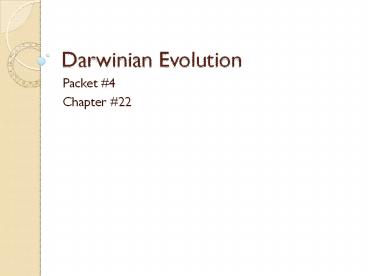Darwinian Evolution - PowerPoint PPT Presentation
Title:
Darwinian Evolution
Description:
Darwinian Evolution Packet #4 Chapter #22 The fossil remains of an organism that lived in a particular geologic age, used to identify or date the rock or rock layer ... – PowerPoint PPT presentation
Number of Views:268
Avg rating:3.0/5.0
Title: Darwinian Evolution
1
Darwinian Evolution
- Packet 4
- Chapter 22
2
Pre-Darwin
- Aristotle believed that organisms were moving
towards a perfect state - Prior to Darwin, fossils was known about for
centuries. - Lamarck proposed the theory of evolution based on
inheritance of acquired characteristics in the
1800s.
3
Darwins Voyage Influences on Thoughts
- Embarked on the H.M.S. Beagle on a 5 year
exploration of South America and the South
Pacific - Darwins thoughts were influenced by
- The specimens and fossils found in South America
and the Galapagos Island. - By knowledge of artificial selection
- Breeders developing varieties of domesticated
plants and animals in few generations. - Read Charles Lyell Principles of Geology on the
voyage - Idea that earth was very old
- Darwin had knowledge of Thomas Malthus idea that
populations should outgrow food supply.
4
Theory of Evolution via Natural Selection
- In 1859, Darwin published book On the Origin of
Species by Means of Natural Selection - Members of a population vary, and some of these
variations are heritable - Organisms produce offspring than can survive to
reproductive age. - Resources available to a population are limited
and therefore limit population growth - Organisms with the most favorable traits have
differential reproductive success, and those
traits are passed to the next generation - Alfred Wallace also, independently, proposed the
same theory.
5
Genetics Darwin
6
Genetics Darwin
- Mendel and Darwin, though unaware of each others
work during their period of studying, studies and
theories are being brought together today - Combines the genetics of populations with tenants
of Darwins theory of evolution. - The Scientists Debate
- If scientists could repeat evolution, would the
results be the same? - Appears that natural selection has a greater
influence than chance.
7
Evidence for the Theory of Evolution
- Fossil Records
8
Fossils
- The remains or traces of ancient organisms
- Bone, teeth, shells, body parts preserved in
bogs, tar, amber or ice - Most commonly found in aquatic environments
- Typically in the form of sedimentary rocks
9
How Scientists Age Fossils
- Most Common Method
- Sedimentary layers nearer to the surface are
younger than those below - Strata (layers of sedimentary rock) can also be
dated by the presence of index fossils - Radioactive dating
- Radioisotopes decay at a characteristic known
rate - The half-life is the amount of time required for
50 of the radioisotope to decay - Potassium-40 is used to date very old fossils
- Carbon-14 is used to date organic remains that
are relatively young
10
Evidence for Theory of Evolution
- Comparative Anatomy
11
Comparative Anatomy
- Demonstrates similarities in structures of
related species. - Homologous Structures
- Similar structure different function
- Example(s) 1
- Arm of human
- Wing of a bat
- Flipper of a whale
- All have similar bones
- Example(s) 2
- Leaf of a tree
- Spine of a cactus
- Tendril of a pea
- Homologous structures in plants
12
Comparative Anatomy II
- Homoplastic features/Analogous Features
- Similar function different structure
- Similar function in quite different, distinctly
related organisms. - Demonstrates convergent evolution
- Adaptation to meet similar environmental or
anatomical demands - Example
- Wing of a bird and the wing of a grasshopper are
homoplastic
13
Comparative Anatomy III
- Vestigial Structures
- Seemingly useless organs or structures
- Humans
- Wisdom teeth
- Muscles that move ears
- Snakes Whales
- Hind limb bones
- Tend to persist
- There is no selective pressure to eliminate them
- Hmmm! Why?
14
Evidence for Theory of Evolution
- Biogeography
15
Biogeography
- The study of the distribution of living things
- Distribution of marsupials
- Distribution of species in the Galapagos
- Darwin
- Continental Drift
- In 1915 Alfred Wegner proposed the ideas that is
now referred to as continental drift - Original super continent, Pangaea, was split into
7 large crustal plates. - Plate tectonics is used to explain the movement
of these crustal plates.
16
Evidence for the Theory of Evolution
- Developmental Biology
17
Developmental Biology I
- Molecular comparisons among organisms completed
via the analysis of nucleotide and amino acid
sequences. - The Genetic Code
- Universal, across all species, that indicates
amino acid sequence. - According to the theory of evolution, the similar
genetic code indicates a common ancestor - Wait! Shouldnt the sequence have changed over
time according to the theory? - Hmmm!
- DNA Sequencing
- Used as a molecular clock to estimate the time
since divergence between 2 closely related
species of taxonomic groups - Can be used to reconstruct phylogeny
- The evolutionary development and history of a
species or higher taxonomic grouping of
organisms. - Because mutation rates vary, molecular clocks
move at different rates - Fossil evidence and radioactive dating help to
clarify evolutionary divergences - Mutations
- Affect the sequence of events during development
- Results in changes over a period of time
18
Phylogeny
- The evolutionary history of a group of related
species - DNA sequencing provides this evolutionary
information - Human and chimpanzee DNA sequences are only about
2 different - Phylogenic trees may be constructed based on
differences in DNA sequences.

